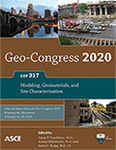Geo-Congress 2020
A System-Level Gravel Loss Prediction Model
Publication: Geo-Congress 2020: Modeling, Geomaterials, and Site Characterization (GSP 317)
ABSTRACT
Granular roadways deteriorate over time due to both external factors (repeated roadway traffic loads and precipitation) and internal factors (weak subgrade soils, poor drainage, and low quality gravel/rock materials). As a result of these factors, granular roadways experience a significant amount of gravel loss during their lifespan. This is one of the main engineering challenges associated with maintaining such roads. Therefore, it is very important for engineers to be able predict annual gravel loss, to enable more reliable predictions for maintenance budgets. A gravel loss prediction model could help predict the amount of roadway surface materials expected to be lost after a given time, and therefore, to a greater extent, indicate to engineers the expected amount of materials to be purchased for the upcoming fiscal year. This tool can play a vital role in making proactive budgetary decisions for roadway maintenance. Existing gravel loss prediction models have mainly been developed to study the roadway material declination patterns on one or more segments in a roadway system. However, section-based gravel loss prediction models may not always be suitable to make network-level material declination predictions, because these models often require site-specific information which may lead to biased results caused by local calibration. In this study, granular road condition and performance data were collected from Iowa counties, and historical information on factors impacting roadway deterioration were obtained from federal government databases. Historical trends of daily traffic and precipitation variations, along with gravel/rock material quality test reports for quarries and soil test reports for counties, were analyzed to determine county-level representative values for each of those factors that contribute to granular road deterioration. Then the system-level roadway gravel loss was modelled using data from a full factorial experimental design. Multiple linear regression (MLR) analysis was also conducted considering county-level averages of daily traffic, precipitation intensity, gravel/rock material quality, and subgrade soil plasticity index as influencing variables. Out-of-sample data prediction and accuracy of fitted models were assessed using cross validation. The developed model can act as a standalone program because site specific data is not required to run the model and therefore, it provides the local agencies with a cost efficient annual gravel loss approximation tool.
Get full access to this article
View all available purchase options and get full access to this chapter.
REFERENCES
Bennett, C. R. & Paterson, W. D. O., (2000). “A Guide to Calibration and Adaption”,(HDM-4 Highway Development and Management, Volume 5). World Road Association, Paris, World Bank, Washington, D.C.
Bureau of Transportation Statistics, (2018). “National Transportation Statistics”, U.S. Department of Transportation, Washington, DC.
Choummanivong, L. & Martin, T. (2004)., “Prediction Models for Unsealed Roads in Western Australia”, ARRB Transport Research Draft Contract Report RC2323A, ARRB TR Vermont South, Victoria, Australia.
Huntington, G. & Ksaibati, K. (2010). “Gravel Roads Management Volume 1”, Report No. FHWA-WY-10/03F, Wyoming Department of Transportation, Cheyenne, WY.
Kerali, H. G. R., (2000). “Overview of HDM-4”,(HDM-4 Highway Development and Management, Volume 1). World Road Association, Paris, World Bank, Washington, D.C.
Kerali, H. G. R., McMullen, D. & Odoki, J.B., (2000). “Applications Guide”, (HDM-4 Highway Development and Management, Volume 2). World Road Association, Paris, World Bank, Washington, D.C.
Martin, T., Choummanivong, L., Thoresen, T., Toole, T, & Kadar, P., (2013). “Deterioration and maintenance of local roads”, Proceedings of Institute of Public Works Engineering Australasia (IPWEA), Darwin, Australia.
Martin, T. & Kadar, P. (2015). “Impact of Various Maintenance Strategies on Unsealed Road Deterioration to Achieve an Acceptable Maintenance Budget & Road Performance,”9thInternational Conference on Managing Pavement Assets, Washington, D.C.
Massachusetts Department of Environmental Protection, (2001). “The Massachusetts Unpaved Roads BMP Manual: A Guidebook on How to Improve Water Quality While Addressing Common Problems”, Project 98-06/319, Worcester, MA.
Odoki, J. B. & Kerali, H. G. R., (2000). “Analytical Framework and Model Descriptions”, (HDM-4 Highway Development and Management, Volume 4). World Road Association, Paris, World Bank, Washington, D.C.
Paterson, W. D. O., (1991). “Deterioration and Maintenance of Unpaved Roads: Models of Roughness and Material Loss”, Transportation Research Record 1291, Washington, D.C., pp 143-156.
Pennsylvania Department of Transportation, (2006). “Environmentally Sensitive Maintenance for Dirt and Gravel Roads”, Report No. USEPA-PA-2005, Harrisburg, PA.
Uys, R., (2011). “Evaluation of Gravel Loss Deterioration Models Case Study”, Transportation Research Record: Journal of the Transportation Research Board. 2205. 86-94.
Van Zyl, G., Henderson, M. & Uys, R., (2007). “Applicability of Existing Gravel-Road Deterioration Models Questioned.” Transportation Research Record. 1989. 217-225., Washington, D.C.
Web Soil Survey, Natural Resources Conservation Services, US Department of Agriculture. Website: https://websoilsurvey.sc.egov.usda.gov/App/WebSoilSurvey.aspx
Wightman, D. C., Stannard, E. E. & Dakin, J. M., (2000). “Software User Guide”, (HDM-4 Highway Development and Management, Volume 3). World Road Association, Paris, World Bank, Washington, D.C.
Information & Authors
Information
Published In
Geo-Congress 2020: Modeling, Geomaterials, and Site Characterization (GSP 317)
Pages: 192 - 200
Editors: James P. Hambleton, Ph.D., Northwestern University, Roman Makhnenko, Ph.D., University of Illinois at Urbana-Champaign, and Aaron S. Budge, Ph.D., Minnesota State University, Mankato
ISBN (Online): 978-0-7844-8280-3
Copyright
© 2020 American Society of Civil Engineers.
History
Published online: Feb 21, 2020
ASCE Technical Topics:
- Climates
- Design (by type)
- Deterioration
- Engineering fundamentals
- Engineering materials (by type)
- Environmental engineering
- Granular materials
- Gravels
- Highway and road management
- Highway transportation
- Highways and roads
- Infrastructure
- Load factors
- Materials characterization
- Materials engineering
- Meteorology
- Models (by type)
- Pavements
- Precipitation
- Structural design
- Traffic analysis
- Traffic engineering
- Traffic models
- Transportation engineering
Authors
Metrics & Citations
Metrics
Citations
Download citation
If you have the appropriate software installed, you can download article citation data to the citation manager of your choice. Simply select your manager software from the list below and click Download.
